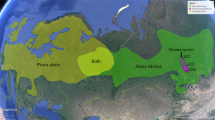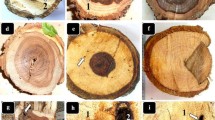Abstract
Recently, severe dieback symptoms have been observed in Agonis flexuosa, a tree native to the south-west of Western Australia. It was suspected that these symptoms were caused by an opportunistic pathogen and a sampling strategy was designed to investigate the causal agent of the cankers in symptomatic trees and the presence (or absence) of this pathogen as an endophyte of asymptomatic trees. Neofusicoccum australe was the most commonly isolated species from cankers of A. flexuosa. It was also the only species isolated which was a known canker pathogen. Agreater diversity of fungi was isolated as wood endophytes of asymptomatic A. flexuosa, but N. australe was again the most common associate. In several cases the same vegetative compatibility group of N. australe was found in cankered and asymptomatic trees. The pathogenicity of isolates of N. australe from cankered and asymptomatic trees towards seedlings of A. flexosa was similar. These data support the hypothesis that the recent dieback of A. flexuosa is caused by a common fungal endophyte, which is capable of causing disease in a stressed host. The disease is not caused by an introduced pathogen. The inciting factors leading to the decline are still unknown.
Similar content being viewed by others
References
Archibald RD, Bowen BJ, Hardy GESJ, Fox JED, Ward DJ (2005) Changes to tuart woodland in Yalgorup National Park over four decades. In ‘Proceedings 6th national conference of the Australian Forest History Society Inc.’. (Ed. M Calver) pp. 363–372. (Millpress: Rotterdam)
Augspurger CK, Kelly CK (1984) Pathogen mortality of tropical tree seedlings: experimental studies of the effect of dispersal distance, seedling density and light conditions. Oecologia 61, 211–217. doi: 10.1007/BF00396763
Burdon JJ (1991) Fungal pathogens as selective forces in plant populations and communities. Australian Journal of Ecology 16, 423–432. doi: 10.1111/j.1442-9993.1991.tb01072.x
Burgess T, Wingfield MJ (2002) Impact of fungi in natural forest ecosystems: a focus on Eucalyptus. In ‘Microorganisms in plant conservation and biodiversity’. (Eds K Sivasithamparam, KW Dixon, RL Barrett) pp. 285–306. (Kluwer Academic Publishers: Dordrecht)
Burgess TI, Barber PA, Hardy GESJ (2005) Botryosphaeria spp. associated with eucalypts in Western Australia including description of Fusicoccum macroclavatum sp. nov. Australasian Plant Pathology 34, 557–567. doi: 10.1071/AP05073
Burgess TI, Sakalidis ML, Hardy GES (2006) Gene flow of the canker pathogen Botryosphaeria australis between Eucalyptus globulus plantations and native eucalypt forests in Western Australia. Austral Ecology 31, 559–566. doi: 10.1111/j.1442-9993.2006.01596.x
Burgess TI, Bihon W, Wingfield MJ, Wingfield BD (2009) A simple and rapid method to determine vegetative compatibility groups in fungi. Inoculum 60(5), 1–2.
Castello JD, Leopold DJ, Smallidge PJ (1995) Pathogens, patterns and processes in forest ecosystems. Bioscience 45, 16–24. doi: 10.2307/ 1312531
Cronin L (1988) Key guide to Australian trees. Reed Books, Sydney.
Davison EM, Tay CS (1983) Twig, branch and upper trunk cankers of Eucalyptus marginata. Plant Disease 67, 1285–1287. doi: 10.1094/ PD-67-1285
Desprez-Loustau ML, Marçais B, Nageleisen LM, Piou D, Vannini A (2006) Interactive effects of drought and pathogens in forest trees. Annals of Forest Science 63, 597–612. doi: 10.1051/forest:2006040
DiGregorio LM, Krasny ME, Fahey TJ (1999) Radial growth trends of sugar maple (Acer saccharum) in an Allegheny northern hardwood forest affected by beech bark disease. The Journal of the Torrey Botanical Society 126, 245–254. doi: 10.2307/2997279
Indian Ocean Climate Initiative (2005) How our rainfall has changed — the south-west. Indian Ocean Climate Initiative, Perth, Western Australia. Available at http://www.ioci.org.au/ (last accessed 23 December 2009)
Jones B, Hillcox S (1995) A survey of the possums Trichosurus vulpecula and Pseudocheirus occidentalis and their habitats in forest at Ludlow, Western Australia. Western Australian Naturalist 20, 139–150.
Jurc D, Ogris N (2006) First reported outbreak of charcoal disease caused by Biscogniauxia mediterranea on Turkey oak in Slovenia. Plant Pathology 55, 299. doi: 10.1111/j.1365-3059.2005.01297.x
Kliejunas JT, Geils BW, Glaeser JM, Goheen EM, Hennon P, Kim M-K, Kope H, Stone J, Sturrock R, Frankel SJ (2008) Review of literature on climate change and forest diseases of Western North America. USDA Forest Service, Pacific Southwest Research Station, General Technical Report PSW-GTR-225, 54 pp.
Manion PD (1981) Tree disease concept. Prentice-Hall, Upper Saddle River, NJ.
Marçais B, Bréda N (2006) Role of an opportunistic pathogen in the decline of stressed oak trees. Journal of Ecology 94, 1214–1223. doi: 10.1111/ j.1365-2745.2006.01173.x
Maresi G, Luchi N, Pinzani P, Pazzagli M, Capretti P (2007) Detection of Diplodia pinea in asymptomatic pine shoots and its relation to the Normalized Insolation index. Forest Pathology 37, 272–280. doi: 10.1111/j.1439-0329.2007.00506.x
Maxwell S, Burbridge AA, Morris K (1996) The 1996 action plan for Australian marsupials and monotremes. Prepared for the Australasian Marsupial and Monotreme Specialist Group. (IUCN Species Survival Commission: Canberra)
Piškur B, Pavlic D, Slippers B, Ogris N, Maresi G, Wingfield MJ, Jurc D (2008) Botryosphaeriaceae involved in die-back of Ostrya carpinifolia in Slovenia and Italy following drought. In ‘9th international congress of plant pathology (ICPP 2008), 24–29 August 2008, Torino, Italy’. S2, 267.
Read DJ (1968) Some aspects of the relationship between shade and fungal pathogenicity in an epidemic disease of pines. The New Phytologist 67, 39–48. doi: 10.1111/j.1469-8137.1968.tb05452.x
Schoeneweiss DF (1981) The role of environmental stress in diseases of woody plants. Plant Disease 65, 308–314.
Shearer BL, Fairman RG, Bathgate JA (1995) Cryptodiaporthe melanocraspeda canker as a threat to Banksia coccinea on the south coast of Western Australia. Plant Disease 79, 637–641.
Shearer BL, Tippett JT, Bartle JR (1987) Botryosphaeria ribis infection associated with death of Eucalyptus radiata in species selection trials. Plant Disease 71, 140–145. doi: 10.1094/PD-71-0140
Slippers B, Wingfield MJ (2007) Botryosphaeriaceae as endophytes and latent pathogens of woody plants: diversity, ecology and impact. Fungal Biology Reviews 21, 90–106. doi: 10.1016/j.fbr.2007.06.002
Taniguchi T, Tanaka C, Tamai S, Yamanaka N, Futai K (2008) Identification of Cylindrocladium sp. causing damping-off disease of Japanese black pine (Pinus thunbergii) and factors affecting the disease severity in a black locust (Robinia pseudoacacia)-dominated area. Journal of Forest Research 13, 233–240. doi: 10.1007/s10310-008-0076-6
Taylor A, Hardy GESJ, Wood P, Burgess TI (2005) Identification and pathogenicity of Botryosphaeria species associated with grapevine decline in Western Australia. Australasian Plant Pathology 34, 187–195. doi: 10.1071/AP05018
Taylor K, Barber PA, Hardy GESJ, Burgess TI (2009) Botryosphaeriaceae from tuart (Eucalyptus gomphocephala) woodland, including the description of four new species. Mycological Research 113, 337–353. doi: 10.1016/j.mycres.2008.11.010
Vannini A, Lucero G, Anselmi N, Vettraino AM (2009) Response of endophytic Biscogniauxia mediterranea to variation in leaf water potential of Quercus cerris. Forest Pathology 39, 8–14. doi: 10.1111/ j.1439-0329.2008.00554.x
Witzell J (2001) Formation and growth of stem cankers caused by Gremmeniella abietina on young Pinus contorta. Forest Pathology 31, 115–127. doi: 10.1046/j.1439-0329.2001.00231.x
Author information
Authors and Affiliations
Rights and permissions
About this article
Cite this article
Dakin, N., White, D., Hardy, G.E.S.J. et al. The opportunistic pathogen, Neofusicoccum australe, is responsible for crown dieback of peppermint (Agonis flexuosa) in Western Australia. Australasian Plant Pathol. 39, 202–206 (2010). https://doi.org/10.1071/AP09085
Received:
Accepted:
Issue Date:
DOI: https://doi.org/10.1071/AP09085




